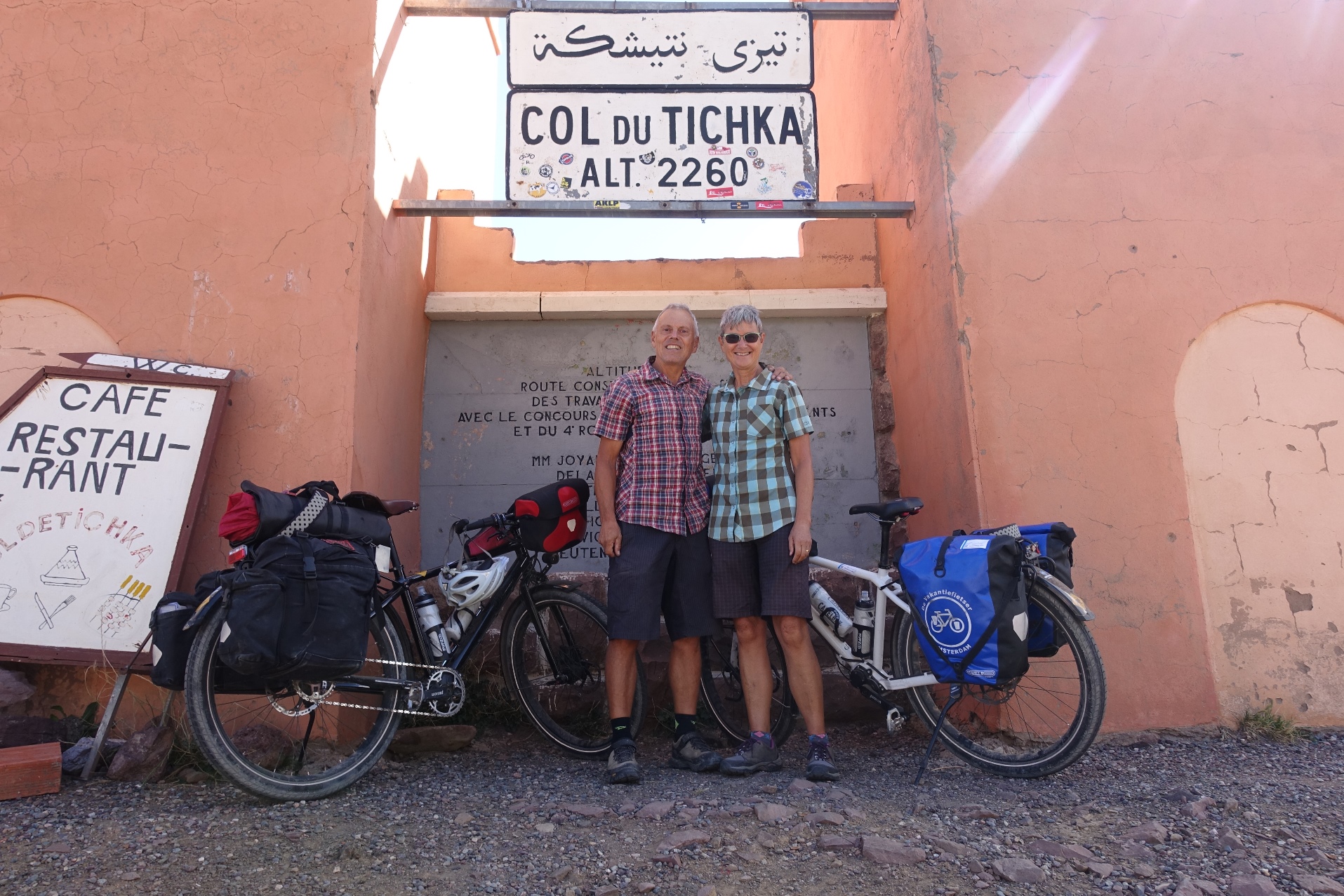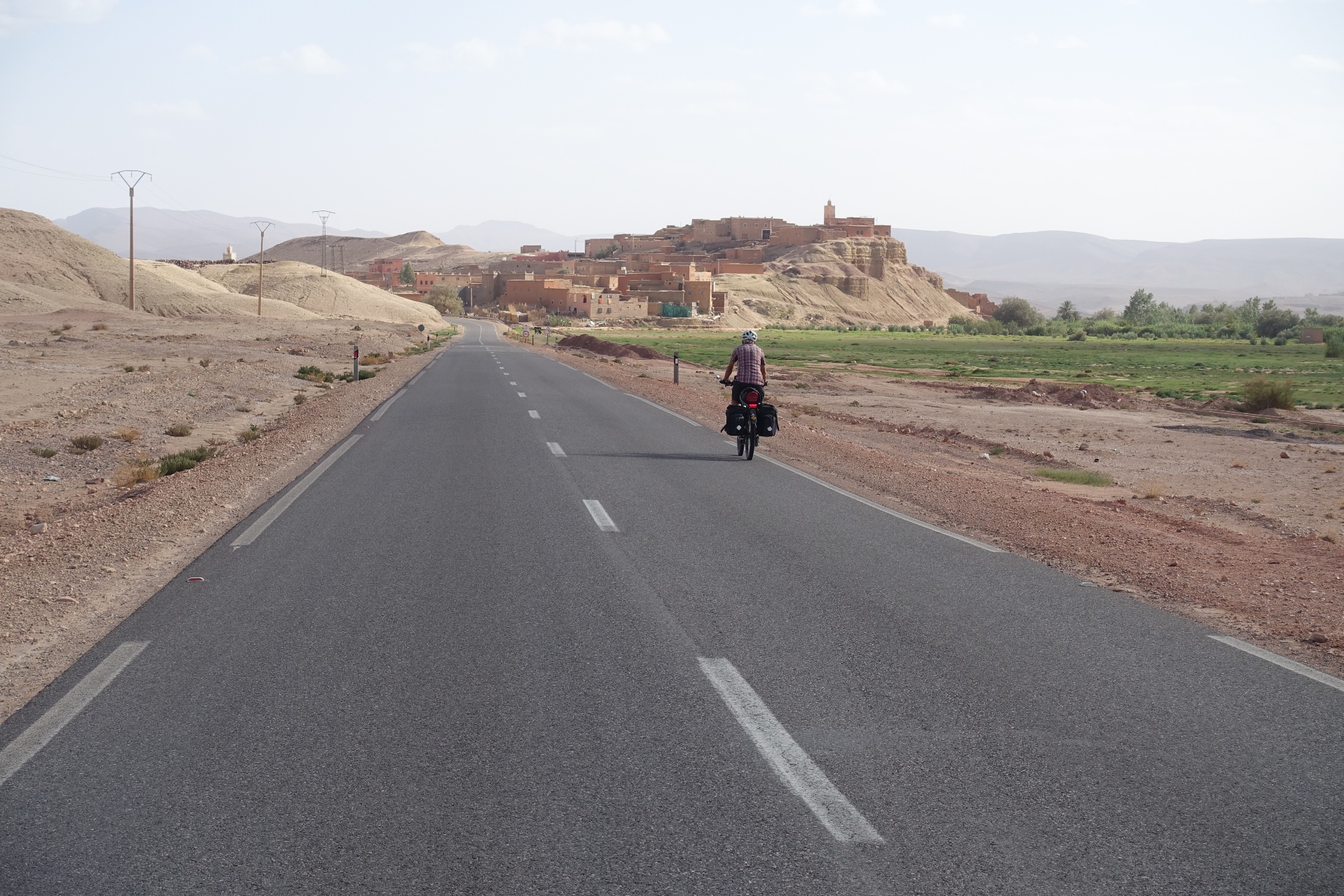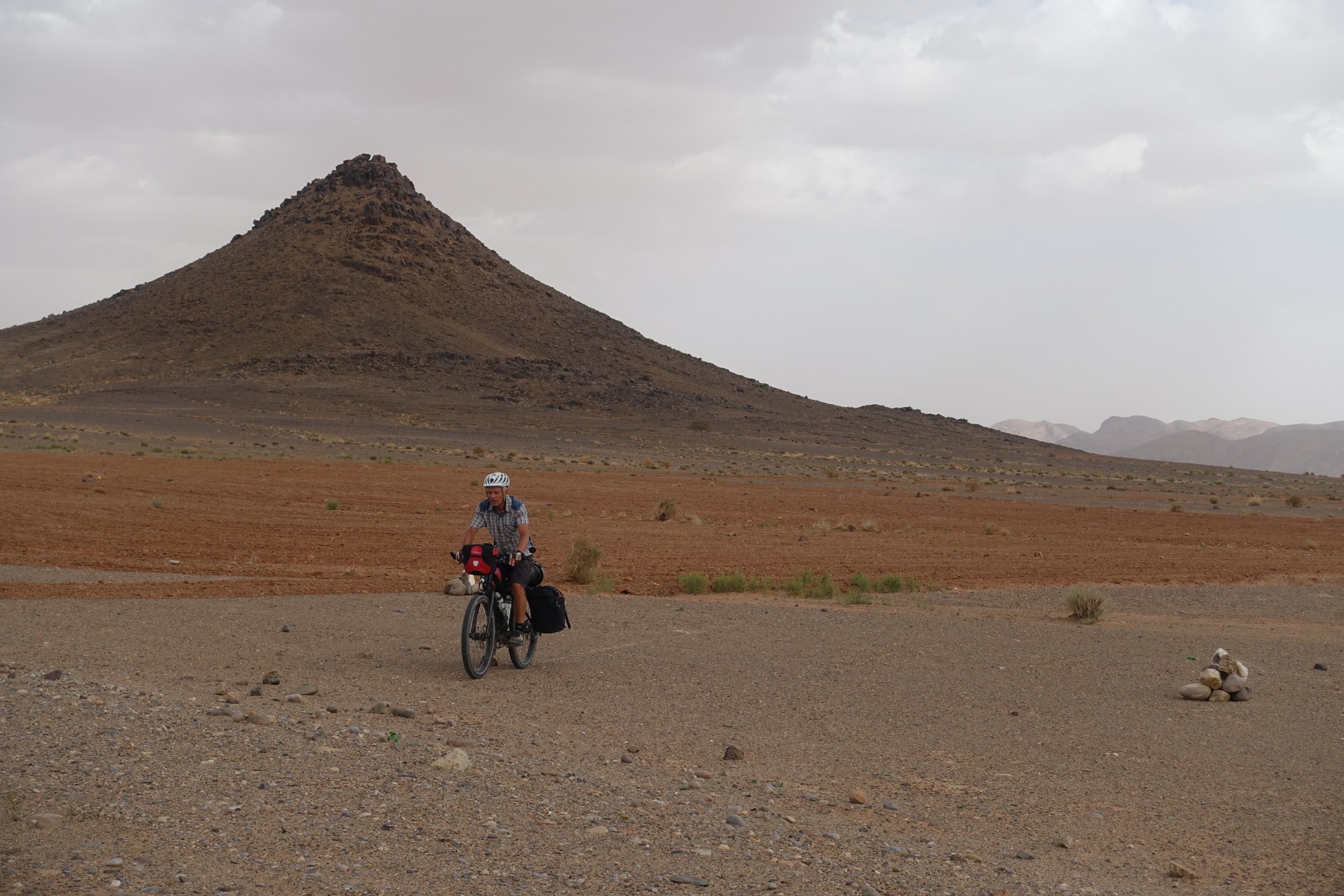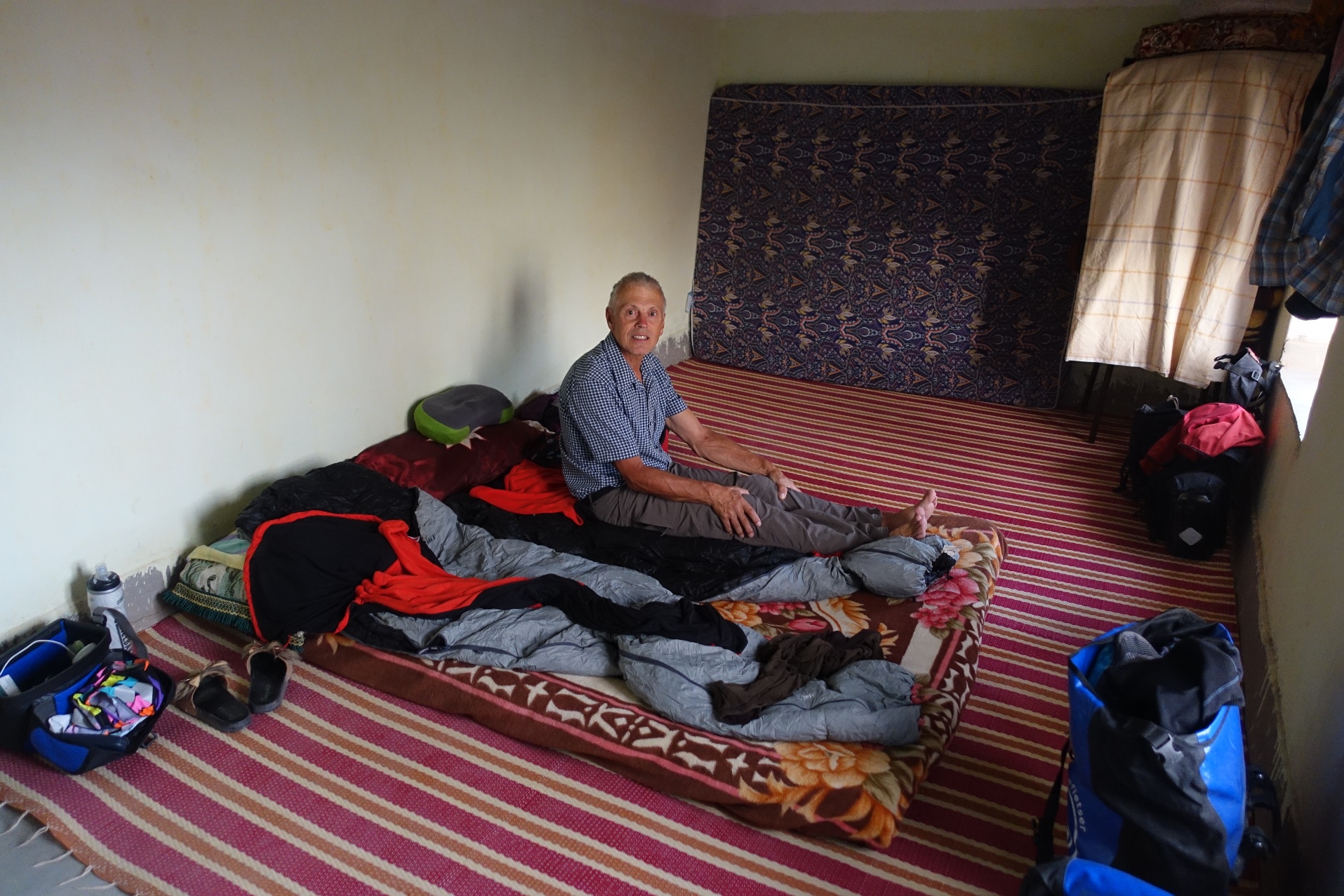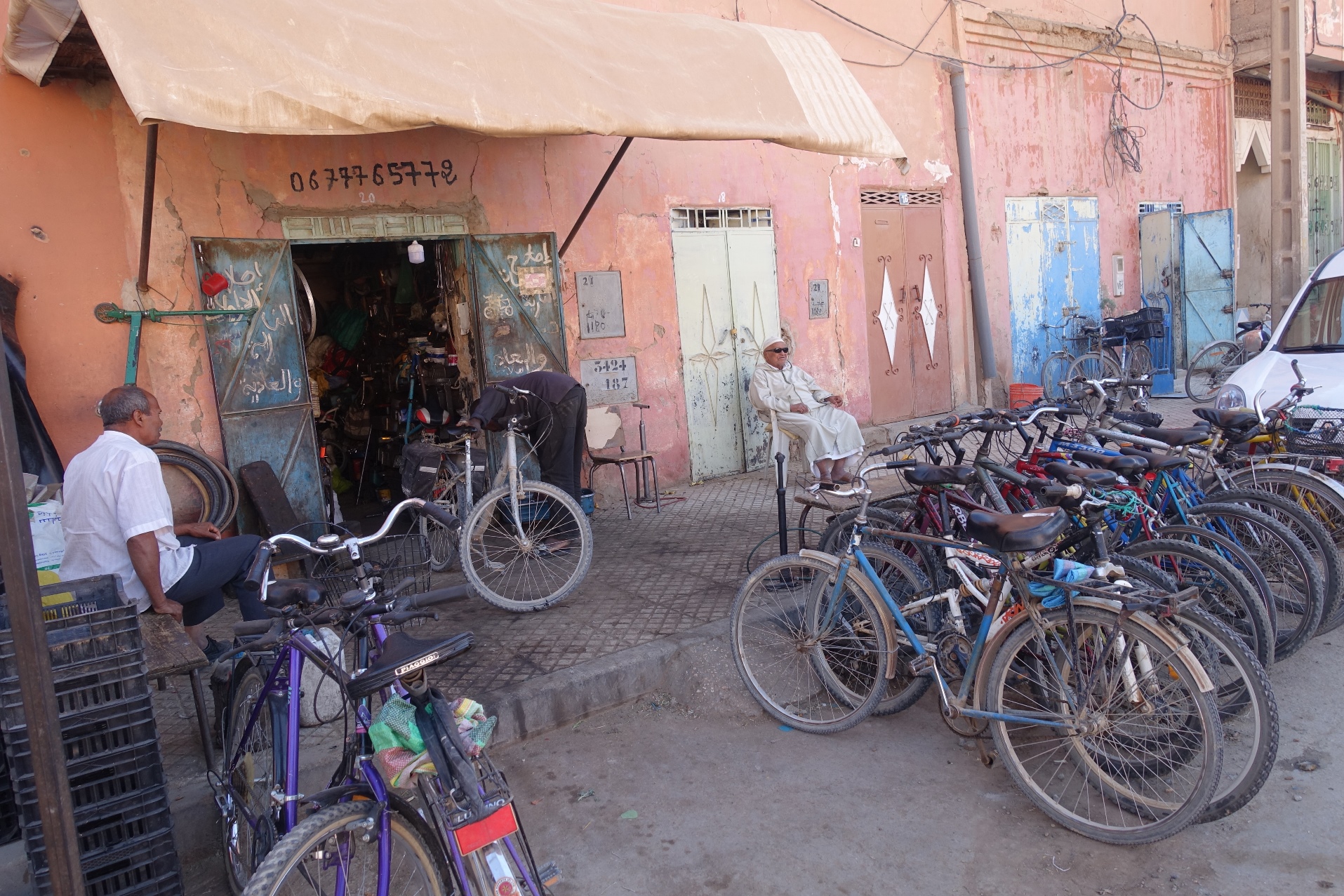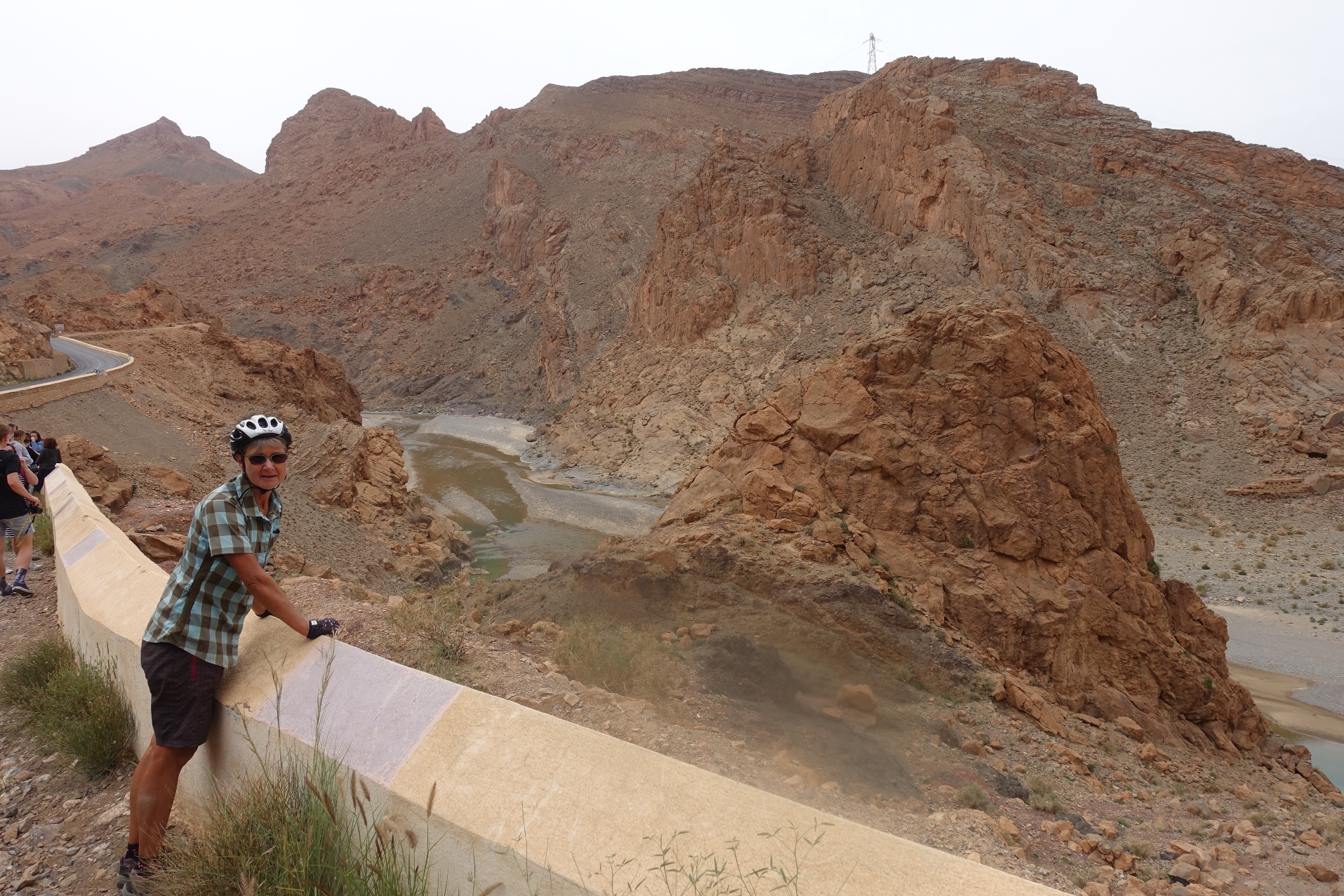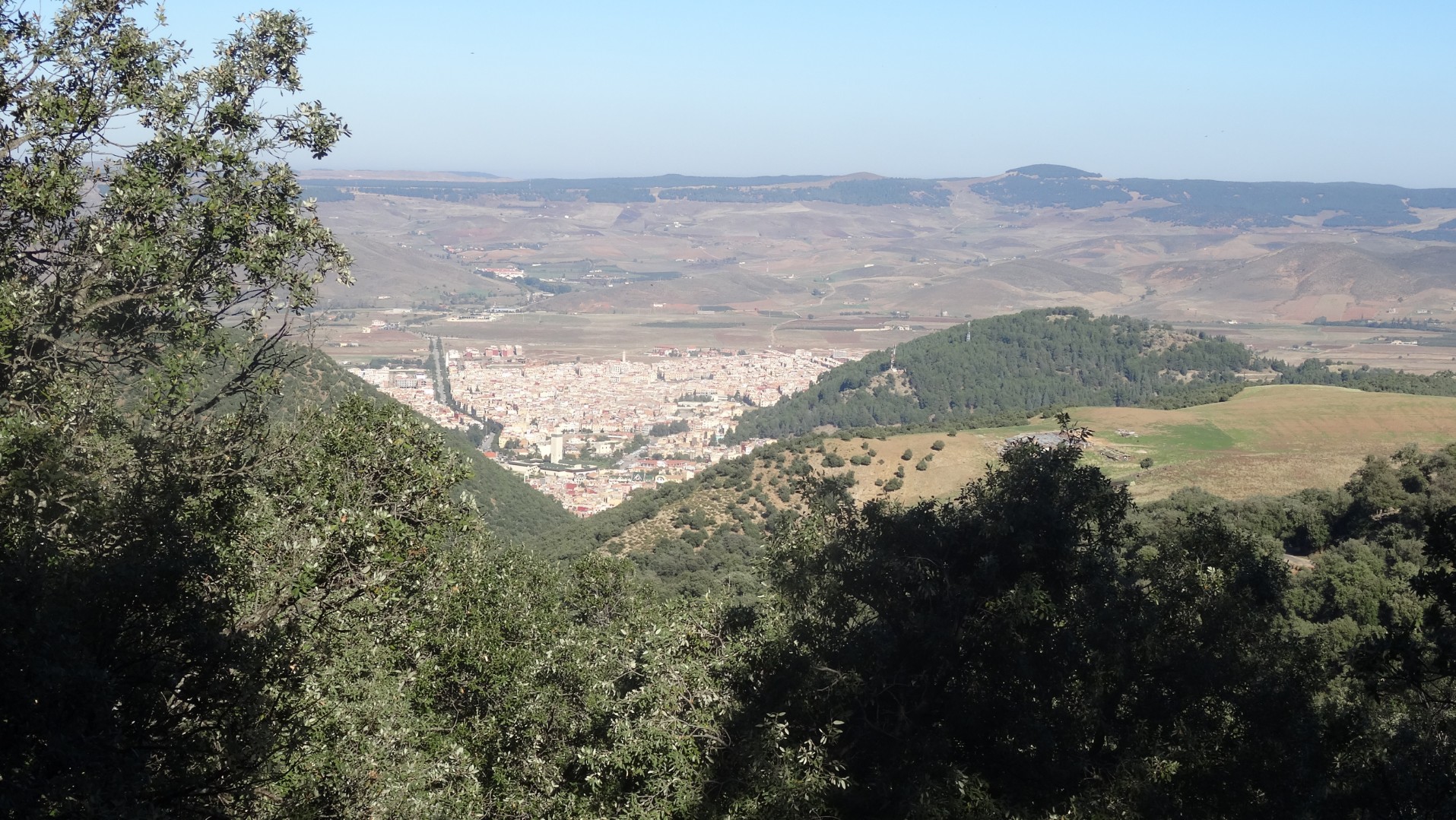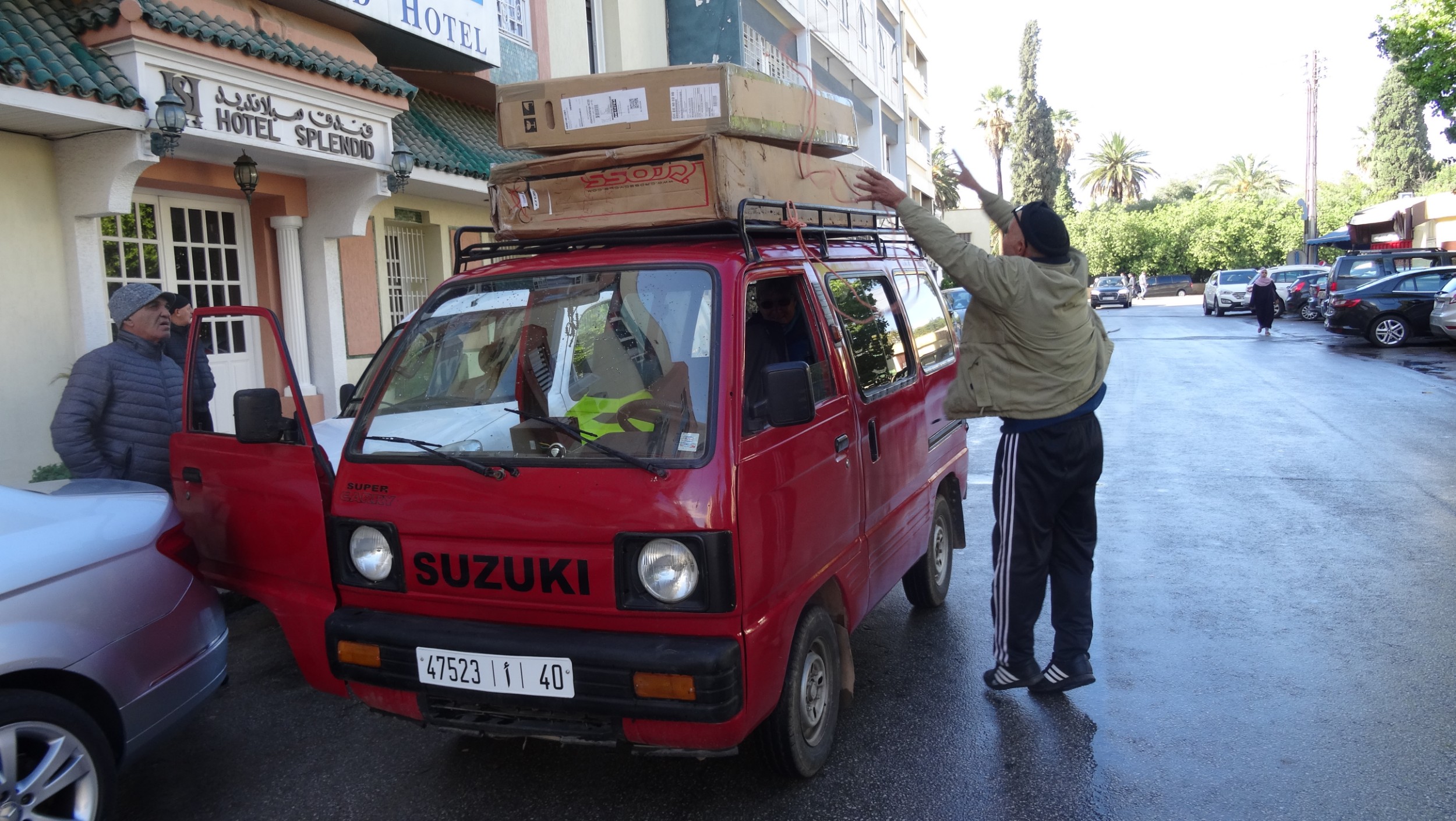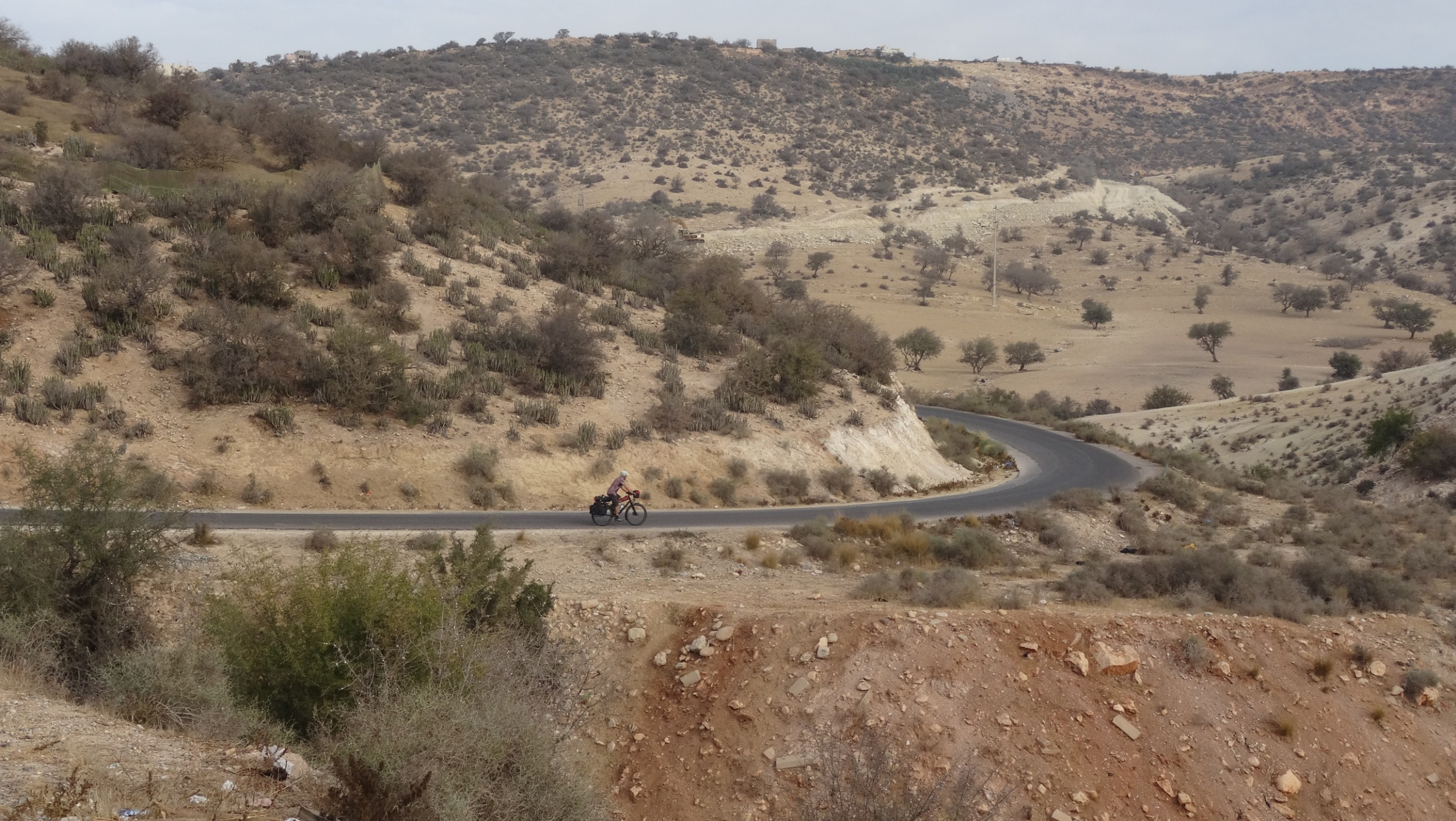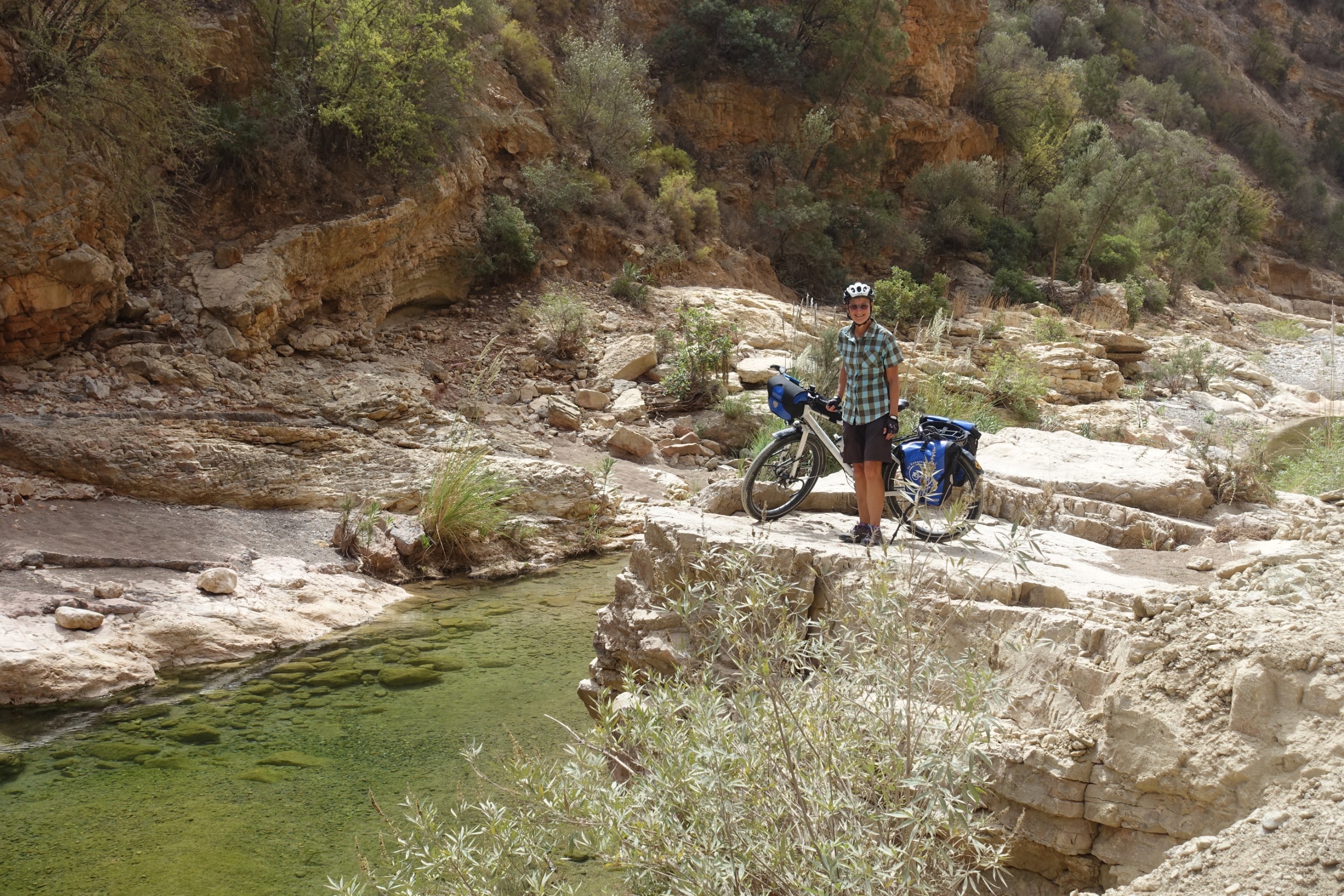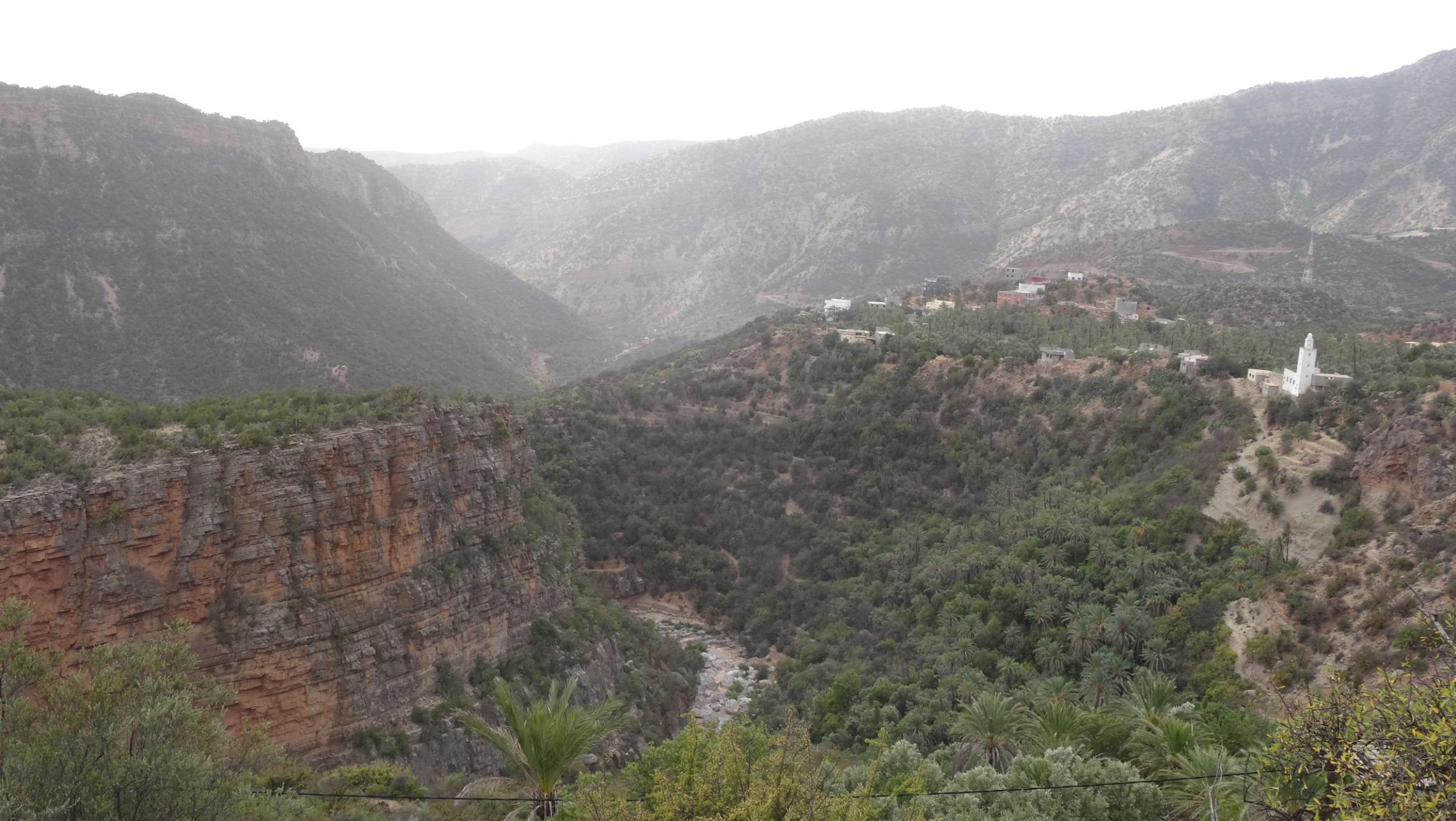Morocco: To the desert and beyond
Louise George
“Where are you from? Welcome to Morocco!” These two statements we heard on a daily basis, said with genuine interest and cordiality; no strings attached! I would however highly recommend having an understanding of French language if travelling in Morocco. My schoolgirl French was very limited. We got by; but we would have liked to have communicated with locals more as that would likely have given us a richer experience.
Travelling on a bike seat can be difficult, but any time, in many of the countries we’ve travelled in, when we’ve chosen to travel by bus with the bikes and our many bags (we each have 4 panniers and a handlebar bag), there has usually been a lot of bike preparation, and difficulties transferring gear. We had already used CTM buses to travel from Agadir to Marrakesh with boxed bikes in the luggage compartment. Now we’ve established that, for a fee, we can freight items from Marrakech to Fez. So the smaller bike box was put inside the larger bike box along with the front panniers and various items we would not need as we rode south. Fingers crossed the very large package will be safely transported from Marrakesh, and will be in Fez when we arrive in a fortnight.
Next we walked up the road to a different bus station and booked a ticket for us to travel on a Supr@Tours bus the next day, from Marrakesh to Ouarzazate. We chose Supr@tours because their timetable was more suitable for us, but we were advised to arrive next day at least 30 minutes before departure to book the bikes as freight. Carrying the bikes would then still be at the discretion of the driver, and it would also be up to the driver to allow us to get off the bus at Tiz’n’Tichka Pass, as we actually want to ride some of the way to Ouarzazate. The bus would save us 106 km of cycling, and a significant amount of climbing.
Tiz’n’Tichka - Ouarzazate 89 kilometres, 355 m ascent
Fortunately, on the day, everything was as we wanted and after a three hour bus journey, the driver pulled over at Col du Tichka, and left us on the roadside with bikes and panniers. Nev quickly got the bikes ready for riding. We took a couple of photos at the highest pass in Morocco, and set off. At 2260m the air was thin, and the landscape bare red soil. We were quite out of breath as we climbed a little more to the highest section of road. I was hoping for a ride of only downhill (descent was 1336 metres) but the total ascent of 355 metres, kept the day honest.
With temperatures up to 35C, the heat from the sun and the warm wind, sucked the energy and the moisture from our bodies. There was no shade so we had one short break in the scorching sun to eat the croissants we had brought along with us for lunch. Later we took a longer break at a cafe to re-hydrate.
Many photo stops stretched out our travel time. We were enthralled by the constantly changing landscape and colour variations. With not being sure what the road surface would be like, we didn’t detour to the tourist attraction area of Ait Benhaddou. On the first day of this cycle tour we were not ready to make it an epic, as had been the case when we rode a three day loop from Agadir, (you can read the blog about that ride here). The modest accommodation we had booked in Ouarzazate, ‘Hotel Valley Rose’ was very comfortable. With a fridge in our room we looked forward to cold drinks at least for the start of tomorrow. Reception offered to store the bikes securely; no trouble, and pointed us in the direction of a shop that sold water and food so we purchased supplies for a back-up.
Ouarzazate - Ait Sedrate Sahi El Ghar, 87.31 kilometres, 750m ascent
It would have been great to start early but the restaurant opened at 7 a.m. and it was actually very dark until that time too. We were packed and ready to leave as soon as we’d eaten. We had watched the sun rise as we ate breakfast, and with the early temperature at a pleasant 17C, we set off to get a head start on temperatures that reached 35C before midday. With only a few photo stops we easily covered the 41km to Skoura, and settled at the first cafe we come across for coffee and Wifi. Later we went into the Skoura town centre, but because we didn’t find anywhere more appealing to eat at, ended up returning to the cafe we had sat at earlier. Nev was just recovering from a couple of days of diarrhoea that started in Marrakesh, and my appetite was dulled because of the heat and dehydration. Even though neither of us was hungry, we knew we needed to eat the meagre lunch we’d chosen of tomato salad and chips.
A soft pink hue kissed the landscape. Distant mountains melted into silhouettes in the heat haze. The arid terrain didn’t seem like it would support a large population so we were surprised to pass through many villages. At a high vantage point on the road, we could see six villages dotted over about a 15 km distance. From our bike seats these villages often appeared to be clusters of small mud brick houses hidden behind walls of the same material, (kasbahs) but we found that there is often quite a large population in the villages, with dwellings that actually extend well back from the road. To locate the typical Moroccan Auberge in the village of Ait Sedrate Sahi El Ghar where we stayed the night, we rode, as if negotiating a maze; along narrow dirt tracks between high walls, to the outskirts of town, about two kilometres from the main road.
Ait Sedrate Sahi El Ghar - near Dades Gorge, 43.31 kilometres, 385m ascent
We chose not to eat breakfast at the auberge for a few reasons; last night’s tagine had been very expensive so we assumed breakfast would probably also be pricey; I had been in hot and cold sweats all night, had hardly slept and didn’t feel like eating, and we wanted to make an early start. We rode out at 7:30, on a snack of Orange Juice and a Meusli Bar. At the main road we passed hundreds of children walking to school. From Kalaat M´Gouna to Boumaine Dades it seemed like Highway N10 was one long route where villages conjoined each other; with houses of the small mud brick variety or grand homes of many levels, all dressed in sandy pink.
We were riding the valley formed by the Dades River. As with any area in Morocco where there is a water source, populations are dense. The small town of Kalaat M’Gouna had an industry of rosewater and rose fragrances. Every second shop was selling rose products. Evidently there is a Rose Festival every May. We continued towards Boumaine but made a left turn just before the town in the direction of Dades Gorge. Only ten kilometres along the road into the gorge, we settled into Hotel Cascades Dades. Nev did bike maintenance, while I napped, then we spent a relaxing afternoon on the terrace perched high above the fields. We were looking down on a group of industrious women who cut the dried stalks off corn plants and stacked them on a donkey, then cleared the remaining stubble, readying the land for the next crop. We decided to stay out of the heat and leave the ride to the gorge until tomorrow.
Dades Gorge - Boumaine Dades, 50 kilometres, 626m ascent
My feeling unwell yesterday turned into Moroccan belly overnight. Breakfast was out of the question for me, however I wanted to see the gorge. We left our panniers and cycled at a gentle pace for the 22 kilometres.
We passed through many small villages along the way. The valley is fed by the Dades River and was densely populated. There were some new buildings under construction; some very grand. We shared the road with women coaxing donkeys loaded with corn plants, presumably to be used for winter stock feed. These swaying loads amused me, but it saddened me that sometimes only two legs were visible and on closer inspection it was an old woman carrying the burden. There were clusters of olive trees and fig, almond and walnut trees dotted the borders of many small fields of corn, from which the cobs had already been picked. Women were industriously chopping the plants at ground level, then drawing them into bundles to load onto the donkeys. The background was of rich red rock. We rode to the top of the gorge for the best views.
A magic descent
The road zigzagged up the rocky escarpment, upon which sat an eyesore of a building. Nev rode a few kilometres further to the head of the gorge then returned to where I had waited at the restaurant/hotel at the top. We had a nice coffee, then returned to last nights hotel for our panniers, before taking the final 10 km to Boumaine. Boumaine is one of the largest towns in the area. It hugs the hillside and blends with the ochre earth. Our accommodation had a view along the oasis of the Dades River, a swathe of deep green at the bottom of the red valley. We walked to a nearby cafe for pizza and an avocado juice. The pizza wasn’t much more than a bread base topped with cheese and herbs and the juice was very milky. I was drinking mine quickly, because I really wanted the experience of consuming it to be finished as soon as possible, as I was feeling a bit ‘grossed-out’. I had glanced across to see another avocado juice being made. The milk comes in plastic bags and the young man making the drink, tore the corner of the bag open with his teeth!
Boumaine Dades - Ait Oussalem and Gorges Todgha, 70.3 kilometres, 405m ascent
There were only a couple of climbs over the 43km to Tinghir. The road went along the centre of a broad arid valley that only supported hardy scrubby bushes. There wasn’t much visible in the way of life except a couple of goat herds and their herder, a flock of scraggly sheep and their shepherd, a group of donkeys. Occasionally a dirt road would branch from the tarmac into the dry hills that bordered the valley, and often a person would be waiting at these intersections, for a bus.
For about three kilometres before Tinghir, we passed through Nouvelle Tinghir. This area was new roading and vacant blocks that would take hundreds of new homes. There was a beautiful new Polytechnic educational complex. Clearly a lot of population growth expected! Tinghir Town was our lunch stop and what a mission it was to find food! My stomach was still delicate and I had a fruit juice drink in mind. Nev just wanted a sandwich or similar. We slowed at each cafe, trying to see what food they served. We went into a couple but I was put off by the poor quality fruit or diced chicken meat sitting out, unrefrigerated. Eventually we settled at a cafe for juice, coffee and icecream!
We rode almost to the head of Todgha Gorge and rested at our accommodation at Ait Oussalem. I had developed full on Moroccan Belly again. When the sun left the gorge we rode to the most spectacular section, the last 600 metres where the canyon narrowed to about 12 metres wide and sheer rock walls towered to 160 metres. The road we were cycling narrowed, and the river that had been flowing on our right, just disappeared. Many people had set up stalls selling scarves and rugs. They were beginning to pack up but we wondered if they might be staying in caves in the area as there were no vehicles parked.
Back at our accommodation we had been hearing a youngster crying on and off, and on entering the dining room noticed that a child was lying in a woman’s lap, with a doctor appearing to be doing sutures on the child´s stomach. We sat at a table at the far side of the room and discussed whether an appendectomy was being performed; and the doctor doesn’t have gloves on! When I was a child I would be unable to continue a meal if there was so much as a hair in the food. Now the dinner, that had been ordered before I was aware I had gastro issues, was placed in front of me, and I tried not to think of my illness, surgical procedures, and teeth tearing at milk containers. Nev had to eat most of the two tagines, salad, bread and fruit. We later discovered the child did have an appendectomy, two weeks ago, and we had witnessed the sutures being removed
Ait Oussalem - Ksar Touroug, 100.30 kilometres, 282 m ascent
A delicious looking Berber Eggs for two, kick started Nevs day. I was still unwell, so ate bread. The ride back out to the valley was grandly picturesque, but we soon left the gorge and were back in the same broad valley of yesterday, this time for 100 kilometres.
We had pinpointed a town, Ksar Touroug, to stop at that we could see on Google maps had three cafes. Surely there would be accommodation. But no; that was not the case. As we had no cooking gear we decided to eat at the Sahara Cafe, where the cook had told us there was no camping, nor accommodation that he knew of. We were on the outskirts of town so we decided we would leave the cafe to find a spot in the desert to camp. As we were about to leave the young man at the cafe asked if we’d like to stay at his house. “We’d love to!” He took us across an open area, then through a double gate, were he introduced us to a woman. She took us upstairs to a room with a mattress on the floor and we set up our camping bed. And so began my evening with Aisha, and later her mother, who joined us after attending to the two cows housed in a walled compound next to the kitchen. We sat on tiny stools on the floor of the kitchen. Aisha prepared the filling for Berber pancakes: Grated Onion, lard, carrot, chopped chilli, basil. We were later joined by Aisha’s father, and Nev, for the evening meal. A small low round table was brought in and, as it was a snack for us, we shared a small portion of their meal; bread torn from the large flat loaf, dipped in oil, with black olives. This was followed by mint tea. We tried to communicate in French, but were now in an Arabic speaking area. Google translate came up with some weird responses, but I did learn that Aisha was a widow with two school age children. She lived here with her parents and her income was from selling breakfast at the weekly Souk.
Ksar Touroug - Erfoud, 52 kilometres, 71m ascent
I agreed to get up at 5 a.m. and go to the Souk with Aisha. We walked in the dark to the cafe, where the cooking facilities were; just a bench and sink and one gas burner. We quietly stepped over someone who was sleeping on the concrete outside, beside the door. I watched Aisha make the Berber Pancakes. Firstly she prepared an enormous mix in a large plastic bowl: 000 grade flour and coarser wheat flour, yeast, and water, set aside to rise. About 6 a.m. the first trucks arrived to set up awnings, designating individual shops of the Souk. By daylight at 7 a.m. there were many stalls ready and the first customer arrived at the cafe for breakfast. I went to the house to get Nev who had packed both our bikes, ready for the day’s ride. We fare-welled Aisha’s dad and were given two enormous pomegranates. Back at the cafe we ate freshly prepared Berber pancake, that is the dough mix cooked neatly in two exact same size pancake-like circles. The filling, prepared last night was spread over the entire surface of one circle and then the two circles were sandwiched together for further cooking. It was a tasty start to the day. We set off with a heartfelt farewell of Aisha and Amin.
As soon as we left the protection of the town buildings we were into a head wind. We weren’t anticipating a long riding day but the force of the wind slowed our pace considerably. The wind intensified and our flat ride resembled an uphill battle. A haze of sand particles obscured the distant range of hills. Sand could not be seen on the road but must have settled between the stones pressed into the tarmac. The tyres of oncoming vehicles sucked out the sand and sprayed it over us, the same as water forms into sheets when wheels pass through puddles on a wet day. Fortunately the battle into the wind was only for a couple of hours, as a change in our direction brought a reprieve.
We passed by many kilometres of what appeared to be rows of holes, with the fill from the holes in surrounding mounds. A number of vehicles parked in one place piqued our interest and this was our cue to stop and take a look. We joined a couple of other English speakers for a guided tour. The area was of sophisticated underground canals called Khettaras, about four to eight kilometres long, used historically as a water source for irrigation. The canal contained the water but the shafts, spaced regularly, were access for maintenance and for aeration. We were shown how water was raised from the canals and also taken down into the canals to walk along a section. They hadn’t been in use since a Dam was built changing access to water, but prior to that the ground water source had been used for irrigation for 1000 of years. The separate rows were so that there were no fights over water rights between the Arabs and the Berber people.
While we rode, we’d often had children wave or run beside us as if we are in a race. To have two boys run either side of the bike was not unusual so I didn’t think anything of it. Seconds later I heard a noise behind and turned in time to see them darting up a sand hill with my locks in their hands. The locks were clipped under the pannier straps and the boys had simultaneously unclipped each side. We stopped and called to them but they just waved the locks, laughing at their cleverness. Nev waved a money note and they scarpered down the slope, threw the locks in Nev’s direction, snatched the money and raced back up and over the sandhill. I’d like to think that the boys were just being pranksters but it was a good warning for us; so the locks were then locked securely to my bike and remained that way for the rest of our trip. Later a young man rode beside Nev for a little while, then later dropped back to ride beside me. He repeatedly asked the same questions in English. I was now paranoid about our valuables and watched Nev’s phone and my Garmin, like a hawk. We slipped the devices into the handlebar bag when the lad wasn’t looking. Oddly enough a little later a man pulled in front of the young man and yelled at him, to which he slunk off. We continued to slip our valuables away whenever anyone rode beside us, or came over to talk; rather than have them on display.
The arid land slowly changed to fertile fields. It looked like some were prepared for planting. It is autumn now and I expect that Spring in Morocco is a very different scene.
Erfoud and Erg Chebbi
We arrived at Erfoud by mid afternoon and had booked a more superior hotel, because we wanted a couple of days break from riding and to celebrate our 43rd Wedding Anniversary. To be honest I’d been sucked in by the tourist hype that the ‘thing to do’ here was join the stream of other romantically inclined travellers and see the sunset over Erg Chebbi, from the back of a camel. I was exhausted from days of cycling while feeling unwell, plonked myself beside the pool and asked Nev to organise our excursion.
Late afternoon the following day, the 4WD arrived and took us to the Erg Chebbi sand dunes south of Erfoud. The track to Sandfisch followed a short section of the Paris to Dakar race. It certainly was fun to be moving faster than our bicycle pace. We arrived at Sandfisch, where we will stay the night and the vehicle was swapped for a camel each. We jostled and swayed as the animals plodded three kilometres towards the large sand dunes, and then they continued to climb with us on their backs for quite a height. Believe me, it was a pleasure to dismount. We’ve travelled almost 5000 kilometres by bicycle with no saddle sore issues, yet an hour on a camel and we both thought our butts were grazed! The camels were hobbled and we walked a little higher up the dune to rest on a blanket, that had been spread out for us by the camel driver. We watched as many other tourists arrived at the foot of the dunes by 4WD, and then mounted camels for a ride of about ten minutes. Lucky them! We were on an enormous dune, not at the top, and the summit didn’t look more than 30 metres away so we set off to conquer it. The distance was deceptive and it took a while to get to the top, but the view was well worth it.
Happy Anniversary!
After many sunset photos, we joined the camels and they carried us off the dune. For fear that we would be too stiff legged to ride our bikes the next day, we chose to dismount at the sandy trail, and walked the 3 km back to the auberge. Dinner was being served when we arrived and we joined another tourist group in the dining room, for a delicious tagine dinner. The evening finished with an open fire outside, and traditional music played by locals. We wanted to shower before bed as we had been romping around in the sand. Evidently a shower is not usually included in the tourist package we had chosen, but we were happy that they changed their minds and let us shower in someone else’s room. We were taken in the dark to our tent accommodation. Sure it was a Berber tent but in reality just a tent. We had been sleeping in our own tent many nights in the past five months.
We rose before sunrise so we could witness the glory of an expanse of sky throwing spotlights that changed the colourful golden tones of the desert.
Our driver returned us to Erfoud where we collected the gear we had left stored at the hotel and were on the bikes by 9:30 a.m.
Erfoud - Er-Erichidia, 83.65 kilometres, 464m ascent
We rode through a broad desert valley with a rift of rock either side. Contrasting with the barren landscape was an oasis of date palms for many kilometres. We stopped at a market. I stayed with the bikes while Nev went to look for bananas and salad vegetables. While waiting I was watching men rummage through boxes of dates, looking for good quality, and thinking to myself, ‘no wonder we get sick, where have their hands been’, then a man walked over to me and kindly gave me some dates that I put in my handle-bar bag.
As usual temperatures were hot and it was hard to find shade for our lunch break. We left the road on a single track towards date palms, and an area that seemed tucked away out sight. Within moments of laying out lunch a boy rode passed on a donkey. Not long after, a man walked by. The man later returned with a handful of dates for us.
We had passed the 5000 kilometres milestone of cycle touring without mishaps, and had hardly finished congratulating ourselves when my tyre went flat. Our first puncture! Nev found a thorn in the tyre, presumably picked up at lunchtime. Within moments we were surrounded by five boys full of business, who took the tube from Nev and found the hole. Another boy carefully checked the interior of the tyre and found two more thorns. Nev couldn’t locate the puncture repair kit and assumed he must have left it behind at Dades Gorge when he had his tool kit out for bike maintenance. We also found that the spare tube Nev had been carrying so carefully, was actually a skinny tube and not for our broad tyre. Nevertheless he inserted that tube and one of the boys helped with inflating it. Then the boy asked if he could have our Lezyne Cycle Pump. No way!
Later in the afternoon we passed through Er-Erichidia; a large town. Keen to get the punctured tube repaired we stopped at a vehicle tyre shop. Success! Later we found the items needed for puncture repair at a bike maintenance shop. Two rounds of bread restocked our emergency provisions and we headed to a family run auberge at a small village not far from town. We were shown to our room and the strains of guitar music filled the house. At dinner we met our host Youssif, the talented young musician, who spoke English. We had hardly spoken to another person in English for weeks and we found it very refreshing to be able to share Australian music with Yousif through YouTube and to learn from him what life was like for his family. His brother who was working in Saudi, telephoned home while we were there. Youssif was a qualified accountant but not happy in that profession, who had decided to open the family home to guests, and manage the Hostel, with Mum as the cook. Dad helped out as well as working on the farm.
Er-Erichidia - Er Rich, 60.45 kilometres, 689m ascent
Breakfast was Berber pancakes, Berber bread, eggs, oil, olives, jam and honey. When we left we were given the Berber Pancakes we had not eaten, for our mid morning snack. The ride of 40 kilometres took us at first high above the Barrage, an enormous lake of water storage. Long climbs led us through the red rocky terrain of the Middle Atlas Mountains. On one gruelling climb we were passed by a car that pulled over a little ahead of us. I must admit I was thinking ‘is this going to be a problem situation for us?’ When a man, very enthusiastic about our effort, came towards us taking photos. We stopped and he offered us water. Turned out he was Karim Mosta, Moroccan Desert Runner, former World Champion and his companion. We felt invigorated as they took delight in what we were doing!
The mountains ended, swapped by a spectacular ride through Gorges de Ziz, following the Ziz River and exiting through Legionnaires Tunnel built by French colonial troops in the 1930s to create a route through to the Ziz Valley that we had just ridden.
Many Peugeot vehicles came towards us and with numbers displayed, it was clear we were on a rally route. We stopped at one car that was parked beside the road, that had people standing around it, and the bonnet slightly ajar. We asked if they had broken down, but no, having the bonnet slightly open made a level surface on which to place the wine and cheeses that was their lunch!
Our ride finished at Er Rich, 3 kilometres from the main road. We had no accommodation booked but found Hotel Tisslite had a room with ensuite. We wandered around the market, and I soon became aware that there were few women in public and that we were the only Westerners. This was an observation rather than a discomfort for me. I must admit though that in Morocco I did feel more comfortable wearing shorts and T-shirt when I was on or pushing my bike. L'sportif was sometimes said as I walked by. We had difficulty finding somewhere to eat. Eventually we asked a female chemist if she could draw a map to a restaurant. We never did find that restaurant but, while searching, came across a snack bar, walked in and ordered the same meal as the only other customer was eating. Our meal of Harissa soup, chips, cold chicken sandwich, was tasty, and fingers crossed okay for our gut. Back at the room, I showered and found the plumbing broken so had a quick cold wash. We eyed the single beds with suspicion and decided to sleep in our own sleeping bags. Er Rich was not on the tourist route, prices were low, indicative of the quality and service but we left feeling like Er Rich was the most honest little town we had stayed in.
Leaving Er Rich for the bus station
Er Rich - Azrou by bus
Early morning we were at the bus station to take a local bus to Azrou. I’m not sure what is worse; cycling up a mountain pass or sitting on a bus amongst people spewing into plastic bags. The bus was however a good choice as most of the journey was a gentle climb through scenery similar to what we had ridden through previously. Because we went all the way to Azrou, we missed out on riding a very long ascent. Once we crossed the Ante Atlas Mountains, the presence of higher precipitation was evident. Fresh meadows were grazed by many sheep herds. The clusters of trees turned into swathes of forest. It was mid afternoon when we got off the bus and we responded to being ushered into a street side cafe, because the waitress spoke English. We were quickly seated and served, but lunch was marred by the smell of caged sheep. Yesterday many trucks and small vans with sheep in cages on the roofs, had come towards us, presumably going to market. Today while we ate, sheep looked down at us from the roof of a small van that was parked next to us at the kerb.
We checked into Riad Azrou, our home for two nights. The accommodation was furnished in traditional Moroccan style, with earthy tones and drapery giving a Bedouin atmosphere. We had a large room with ensuite on the ground floor adjacent to the lounge area, where we parked our bikes. Breakfast was served each morning on the roof.
Azrou - Ain Leuh - Azrou, 51.36 kilometres, 809m ascent
Looking down to Azrou
Azrou is nestled in the Middle Atlas Mountains, with a backdrop of lush forest and a fertile valley stretching out below. We took the opportunity to ride unloaded on a loop from Azrou, at first climbing up to the forest behind the town and for many kilometres along the hillside in the shadow of the trees. Eventually we were rewarded with many kilometres of downhill passing acres of stone fruit trees. There were new fields being prepared for planting. It looked like machinery had recently moved the enormous boulders that would have been scattered over the area, into piles, or to create a boundary, freeing the fertile soil for production. Our destination was Ain Leuh, a small town that had a waterfall. We knew, as it was the end of summer, that there would likely be no water, and we were right, but were surprised to see that for many kilometres we followed an aqueduct of fast flowing water that delivered water to homes and fields. We rode down the steep main road of Ain Leuh, dodging people and shop-front wares that intruded into the narrow street. We continued a small distance beyond the town to where the weekly Souk was spread under canvas shelters.
Many times we have seen vans with all sorts of goods stacked on the roof and covered in netting. These are mobile shops, going from one village Souk to the next. The stalls are set up and dismantled each day. What an effort, and as an observer, it seemed for little reward! Our loop route returned to Azrou, following the valley. Now and again we were passed by taxis dropping off passengers or pick-up trucks with many people standing in the back tray, getting a ride home.
Azrou - Ifrane, 29.5 kilometres, 766m ascent
Our destination was Ifrane but we took the 'scenic' route. Over eight kilometres we climb 500 metres to get to the Cedar Forest of Ifrane National Park. The ancient trees stood proudly on the hilltops. We saw the occasional monkey. Back on the main road we continued to climb to within ten kilometres of Ifrane before we got a breather. Ifrane in the distance was an unexpected sight. The buildings are all white with pointed red-tile roofs; certainly nothing like the kasbah style of town we have seen throughout Morocco.
Ifrane to Fes, 66.39 kilometres, 115m ascent, 1301m descent
Our last day of cycle touring in Morocco, was the most delightful of rides. We rode our fully loaded bikes for 66 kilometres at an average speed of 25.4 kilometres an hour. Not because we had become super strong by rotating those pedals on loaded bikes, but because apart from the first couple of kilometres, it was all down hill! We stopped in Ouled Tayet for breakfast and coffee at a cafe that was sparkling clean. Such a contrast to the dirt and dust that we had previously experienced. We didn´t stop for any photos.
We retrieved our bike boxes from Fes bus station and packed the bikes ready for their next unridden journey; by bus to Casablanca, followed by a long flight to South Korea. You can read about our ride of the South Korean River Trails here.

